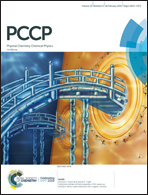Density-based descriptors and exciton analyses for visualizing and understanding the electronic structure of excited states†
Abstract
Analysis and interpretation of the electronic structure of excited electronic states are prerequisites for developing a fundamental understanding of photochemistry and optical properties of molecular systems and an everyday task for a computational photochemist. Hence, wavefunction-based and density-based analysis tools have been devised over the last decades, and most recently also a family of quantitative exciton-wavefunction based descriptors has been developed. While the latter represent the main focus of this perspective, they are also discussed in the context of other existing analysis methods. Exciton analysis bridges the gap between the physically intuitive exciton picture and complex quantum-chemical wavefunctions by yielding insightful quantitative descriptors like exciton size, hole and electron size, electron–hole distance and exciton correlation. Thereby, not only a comprehensive characterization of the electronic structure is provided, but moreover, the formalism is automatizable and thus also optimally suited for benchmarking excited-state electronic structure methods.

- This article is part of the themed collection: 2019 PCCP HOT Articles


 Please wait while we load your content...
Please wait while we load your content...